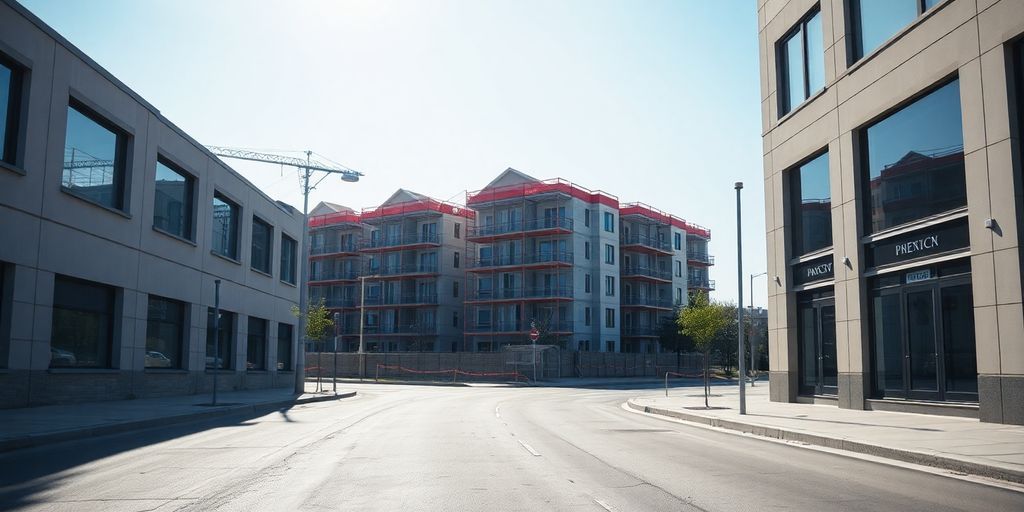From Smart Homes to Hot Markets: Navigating the Shifting Landscape of Texas Real Estate
Blog Author - Published Date
So, you're looking at Texas real estate, huh? It's a big state with a lot going on, and the property market is just as varied. From booming cities to quieter towns, things are always shifting. We're going to take a look at what makes this market tick, from job growth and population changes to how much homes cost and what new tech is shaking things up. It's all about understanding the opportunities and the challenges in this dynamic space.
Key Takeaways
- Texas has a strong economy, with lots of jobs and people moving in, which really pushes up demand for homes.
- The housing market here is pretty competitive, with not a lot of homes for sale, especially in popular areas. This means prices can go up.
- Things like mortgage rates really change how easy it is for people to buy a home, and buyers often have to compete with each other.
- Many different types of people are buying and selling homes in Texas, from first-timers to investors, and real estate agents help them all out.
- New technology is changing how homes are bought and sold, making things faster and easier for everyone involved.
The Economic Landscape of Texas
Job Market Strength and Growth Hubs
Texas's job market is a powerhouse, plain and simple. It's a major reason why people are flocking here. You see companies relocating and expanding, which creates jobs, and those jobs bring in more people. We're talking about serious market growth, especially in cities like Austin, Dallas, and Houston. It's not just about the number of jobs, but also the variety. You've got tech, energy, healthcare, and a bunch of other sectors all contributing.
- Tech Industry
- Energy Sector
- Healthcare Services
The Texas Workforce Commission keeps a close eye on these trends, and their reports consistently show a positive outlook. It's not all sunshine and roses, of course, but the overall picture is pretty bright.
Population Influx and Demand Drivers
People are moving to Texas in droves, and that's putting pressure on the housing market. It's not just about the job market, although that's a big part of it. The lower cost of living compared to places like California or New York is a huge draw. Plus, there's the whole Texas vibe – a certain independence and a business-friendly environment. All these new residents need places to live, which is driving up demand for housing.
- Lower cost of living
- Business-friendly environment
- Job opportunities
Gross State Product and Economic Robustness
Texas's economy is huge. Like, really huge. The Gross State Product (GSP) is up there with some entire countries. That economic strength translates into a more stable real estate market. When the economy is doing well, people are more confident about buying homes. They're less worried about losing their jobs, and they're more willing to invest in property. It's all connected.
| Year | Gross State Product (USD Trillions) |
|---|---|
| 2023 | 2.4 |
| 2024 | 2.7 |
| 2025 | Projected 3.0 |
It's worth keeping an eye on the GSP because it gives you a good sense of the overall health of the Texas economy. If it keeps growing, that's generally a good sign for the real estate market.
Housing Market Dynamics in Texas
The Texas real estate market is a complex beast, influenced by a bunch of different factors. It's not just about building houses; it's about how many people want them, where they want them, and what they can afford. Understanding these dynamics is key if you're thinking about buying, selling, or investing in Texas real estate.
Supply and Demand Balance
The balance between supply and demand is a major driver of home prices and sales volume. When there are more buyers than houses, prices tend to go up. When there are more houses than buyers, prices might stagnate or even drop. Right now, in some parts of Texas, demand is still outpacing supply, especially in desirable urban areas. This can lead to bidding wars and quick sales. Population growth is a major factor, with more people moving to Texas for jobs and a lower cost of living compared to other states.
Inventory Levels and Market Competition
Inventory levels—the number of homes available for sale—play a big role in how competitive the market is. Low inventory means more competition among buyers, while higher inventory gives buyers more options and more negotiating power. New construction is trying to keep up with demand, especially in suburban areas, but it's a constant game of catch-up. Keep an eye on cities like Dallas and San Antonio, where listing activity has seen some increases. Austin, however, is still a hot market where demand is likely to stay ahead of supply.
Regional Variations in Home Values
Texas is a big state, and the real estate market varies a lot from region to region. What's happening in Houston might be totally different from what's happening in El Paso. Northern Texas, including cities like McKinney and Arlington, is seeing growth in both residential and commercial sectors. Southern Texas, with areas like McAllen and Brownsville, offers a more relaxed market with more affordable options. Houston has a large and diverse market with a wide range of property types. Understanding these regional differences is important for making informed decisions.
The Texas real estate market is not a monolith. Different regions experience different market conditions, influenced by local economies, job growth, and population trends. What works in one area might not work in another, so it's important to do your research and understand the specific dynamics of the area you're interested in.
Pricing and Affordability in Texas
The Texas real estate market is heavily influenced by mortgage rates and how they affect whether people can actually afford a home. The intense competition among buyers often dictates how homes are priced. It's a wild ride out there!
Impact of Mortgage Rates on Affordability
Mortgage rates are a critical factor. They really determine how affordable homes are in Texas. Rates have been all over the place, and the Texas Housing Market has seen some big changes. Recently, mortgage rates were around 7.2%, which is up from last year. This directly impacts how much people can borrow and what their monthly payments look like. It's a big deal!
Competition Among Buyers and Pricing Strategies
The Texas real estate market is super competitive because there aren't enough homes for everyone who wants one. This shortage drives up prices, especially for homes that are in good shape and in nice neighborhoods. Sellers can often get away with asking for more because there are so many buyers fighting over the same properties. It's a seller's market in many areas.
Median Home Prices and Fluctuations
Median home prices in Texas have been on a rollercoaster. They went up a lot in recent years, but things are starting to cool down a bit. Some experts think that price growth will be slower than before, which could mean a more stable market. Here's a quick look at how prices have changed in some major cities:
| City | Median Home Price (2023) | Projected Change (2025) |
|---|---|---|
| Austin | $450,000 | +4% |
| Dallas | $380,000 | +5% |
| Houston | $320,000 | +3% |
| San Antonio | $280,000 | +6% |
Understanding these trends is key for both buyers and sellers. While some areas might see only small price increases, Texas remains an attractive market for long-term investment because of its stable growth and relative affordability. Keep an eye on those home listings!
It's important to remember that these are just projections, and the market can change quickly. Staying informed is the best way to make smart decisions about buying or selling a home.
Homeownership Trends in Texas
The Texas housing market is always changing, and understanding homeownership trends is super important for both buyers and sellers. Let's take a look at what's happening right now.
First-Time Homebuyer Activity
First-time homebuyers are a big part of the Texas real estate scene. They're often looking for single-family homes that offer space and potential for appreciation. The number of first-time buyers can change based on the economy and interest rates. They are always on the lookout for homes for sale that fit their needs and budget.
Single-Family Home Sales Preferences
Single-family homes remain the top choice for many Texans. People like having their own space and a yard, especially families. Here's a quick look at why:
- Privacy and space are key.
- Room for kids and pets to play.
- Potential for customization and improvements.
Single-family homes offer a sense of stability and community that appeals to many buyers. The demand for these properties often drives market trends and influences pricing strategies.
Investor Outlook and Rental Property Yields
Investors play a significant role in the Texas real estate market. They're always looking for opportunities to buy properties and rent them out. Here are some things they consider:
- Rental yields in different areas.
- Property management costs.
- Potential for long-term appreciation.
For those looking for investment tips, keep an eye on areas with strong job growth and increasing populations. These areas tend to have higher rental demand and better returns. Investors should also consider the impact of Texas's housing market on their investment strategies.
Key Players in the Texas Real Estate Market
Homebuyers' Diverse Profiles
Texas sees all kinds of homebuyers. You've got first-timers just trying to get their foot in the door, and then you've got people who've been through the process before, looking to move up or maybe downsize. What they're all looking for is a good deal for the lifestyle they want. First-time homebuyers are usually hunting for something affordable, while the luxury crowd wants all the bells and whistles in a prime location.
Home Sellers' Market Position
Being a home seller in Texas can be a wild ride. Sometimes the market is hot, and sellers are in the driver's seat, able to get top dollar. Other times, it's a bit tougher. Location is a big deal, and so is how well the property has been kept up. If you've got a place in a popular neighborhood that's in good shape, you're in a much better spot to negotiate a higher price.
Real Estate Professionals' Role
Real estate agents are the glue that holds the Texas market together. They're the ones who connect buyers and sellers, and they bring a ton of knowledge to the table. They know the local market inside and out, and they can help clients navigate the whole process, whether it's a seller's market or a buyer's market. They can also help find investment opportunities.
Real estate agents are more than just salespeople; they're advisors, negotiators, and problem-solvers. They help people make one of the biggest financial decisions of their lives, and they play a vital role in the Texas economy.
Technological Innovations in Texas Real Estate
Smart Home Technology Influence
Smart home tech is changing the game. Think about it: thermostats you can control from your phone, security systems that send alerts straight to your wrist, and lighting that adjusts to the time of day. These features aren't just cool; they're becoming expected, especially among younger buyers. This demand is pushing up property values for homes that are already equipped. It's not just about convenience; it's about energy efficiency and security, too. Smart tech is becoming a must-have, not just a nice-to-have, in the Texas market. The rise of enhance property management is a testament to this shift.
Digital Transaction Streamlining
Remember the days of endless paperwork and waiting weeks to close on a house? Those days are fading fast. Digital tools are making the whole process smoother and faster. E-signatures, online portals for document sharing, and virtual closing rooms are becoming standard. This isn't just about convenience; it's about efficiency and transparency. Buyers and sellers can track progress in real-time, reducing stress and uncertainty. It's a win-win for everyone involved. The regulatory landscape is also adapting to accommodate these changes, making digital transactions even easier.
Online Platforms and Consumer Expectations
Online platforms have completely changed how people search for and buy homes. Gone are the days of relying solely on real estate agents to find listings. Now, buyers can browse thousands of properties from the comfort of their couch. This has led to increased consumer expectations for transparency, detailed information, and easy access.
Here's what I'm seeing:
- More detailed property listings with high-quality photos and virtual tours.
- Real-time updates on market trends and pricing.
- Personalized recommendations based on individual preferences.
The rise of these platforms is also impacting urban development. People are using online tools to research neighborhoods, schools, and amenities before making a move. This is forcing developers to focus on creating communities that meet the needs of today's tech-savvy buyers. The housing market is more accessible than ever.
Environmental Factors Affecting Real Estate in Texas
The Texas real estate market isn't just about location, location, location. It's also about environment, environment, environment! Several environmental factors significantly shape property values, demand, and the overall appeal of different regions. Let's take a look.
Influence on Property Values
Environmental concerns can really impact what a property is worth. For example, properties in areas prone to flooding or hurricanes often see fluctuating values due to increased insurance costs and buyer hesitation. Coastal erosion is another big factor, especially along the Gulf Coast. The closer you are to the water, the more you have to consider these risks.
Demand and Regional Attractiveness
Certain environmental amenities can boost demand. Think about lakefront properties or homes near parks and green spaces. Access to clean water is also a major draw, especially in drier parts of the state. The regulatory environment plays a big role here, influencing how land can be developed and what environmental protections are in place.
- Access to green spaces
- Water availability
- Air quality
Future Considerations for Development
Looking ahead, developers and buyers need to think about long-term environmental sustainability. This includes things like water conservation, energy efficiency, and resilience to extreme weather events. Climate change is already impacting insurance rates and property values, and that trend is likely to continue.
Considering the long-term environmental impact of a property is becoming increasingly important. This includes factors like water usage, energy efficiency, and the potential for renewable energy sources. Ignoring these factors could lead to decreased property values and increased costs down the road.
Wrapping Things Up: What This Means for You
So, what's the big takeaway from all this talk about Texas real estate? Well, it's a pretty interesting place, that's for sure. You've got some areas where things are really picking up, with lots of people moving in and jobs popping up. Then, there are other spots that might be a bit slower, or even seeing prices go down a little. It's not a one-size-fits-all kind of market. If you're thinking about buying, selling, or even just investing, staying in the loop is super important. Things can change fast, and knowing what's happening in your specific area can make a huge difference. It's all about being ready for whatever comes next in this big, diverse state.
Frequently Asked Questions
How does Texas's strong economy affect its housing market?
Texas's economy is super strong, with lots of jobs and people moving here. This makes more folks want to buy homes, which keeps the housing market busy and prices up.
What does 'supply and demand' mean for Texas home prices?
The number of homes for sale compared to how many people want to buy them is key. If there aren't many homes, prices usually go up because buyers compete more. Right now, there aren't enough homes in many parts of Texas.
How do changing mortgage rates impact what I can afford in Texas?
When mortgage rates go up, it costs more to borrow money for a house. This can make homes less affordable for some people, even if prices stay the same. It can slow down how many homes are bought and sold.
Who are the main types of homebuyers in Texas?
First-time homebuyers are a big part of the market, especially for single-family homes. Investors also play a role, looking for properties to rent out or fix up and sell for a profit.
How is technology changing the way people buy and sell homes in Texas?
New technologies are making it easier to buy and sell homes. Things like smart home devices, online paperwork, and virtual tours are changing how people look for and purchase properties.
Do environmental factors play a role in Texas real estate?
Things like weather patterns, water availability, and natural risks (like floods) can affect where people want to live and how much properties are worth. These environmental factors are important to consider for future development.














